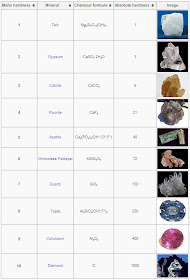 |
| Mohs Scale of Hardness: Image courtesy of www.thegemchronicles.com |
The Mohs Scale (also knowns as the Mohs Hardness Scale or Mohs Scale of Hardness) was developed by the German geologist Friedrich Mohs in 1812 and is widely used by lapidaries to describe the hardness of a given mineral or gemstone. Diamond was, at the time, the hardest material known to exist so is at the top of the list, with Talc being at the bottom.
Essentially what the Mohs scale does is describe the scratch resistance of a given material compared to other minerals. To simplify this, referring to the above table, gypsum will scratch talc therefor gypsum is harder than talc. Likewise corundum (sapphire, ruby etc) will be scratched by diamond so is therefor softer.
To find the Mohs classification of a particular gemstone or mineral one needs to find the softest material that will be scratched by the given gemstone, or find the hardest material that will be scratch by the given gemstone. The gemstone is then given a relative number.
To give an example of this, steel will (in general terms) scratch Fluorite, but will be scratched by Apatite, giving steel a Mohs rating of 4 - 4.5
 |
| Mohs Hardness Scale with additional column titled 'Absolute Hardness' |
So from now on, when I refer to the 'Mohs Hardness Scale' when discussing gemstones, you will know what I am on about!
Feel free to also check out my How-To guide on cutting a stone cabochon and my tutorial on creating gemstone scales for Swiss Army Knives
And if you like the content of this blog, feel free to share!
Until next time!
No comments:
Post a Comment